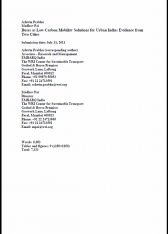
Madhav Pai & Ashwin Prabhu
Promoting the use of public transport is seen as one of the key strategies for moderating the inevitable growth of carbon emissions from urban transport in India. For the majority of Indian cities, this means promoting the use of public bus systems. However, the absence of analyses on carbon emissions savings attributable to public bus services in Indian cities is a significant gap in the literature. This paper utilizes recently available data on bus system performance, travel characteristics and emissions factors to estimate the emissions savings from public bus services in two cities – Ahmedabad and Bangalore. Three types of emissions savings estimates are calculated - past savings from increased ridership in the 5 years from 2005-2010, the current rate of savings from the newly introduced Janmarg BRTS and Big10 trunk services in Ahmedabad and Bangalore respectively, and forecasted savings for the years 2021 and 2031. All three estimates indicate that public bus services produce significant reductions in carbon emissions. The advantages of investing in bus systems over other potential strategies for reducing urban transport emissions – relatively low cost and quick implementation – suggest that they should be a high priority for both governments as well as international funding mechanisms for climate change mitigation.
The paper is also available here online. If you have any questions, or would like to know more about this research, contact Madhav Pai at madhav.pai@wri.org.
